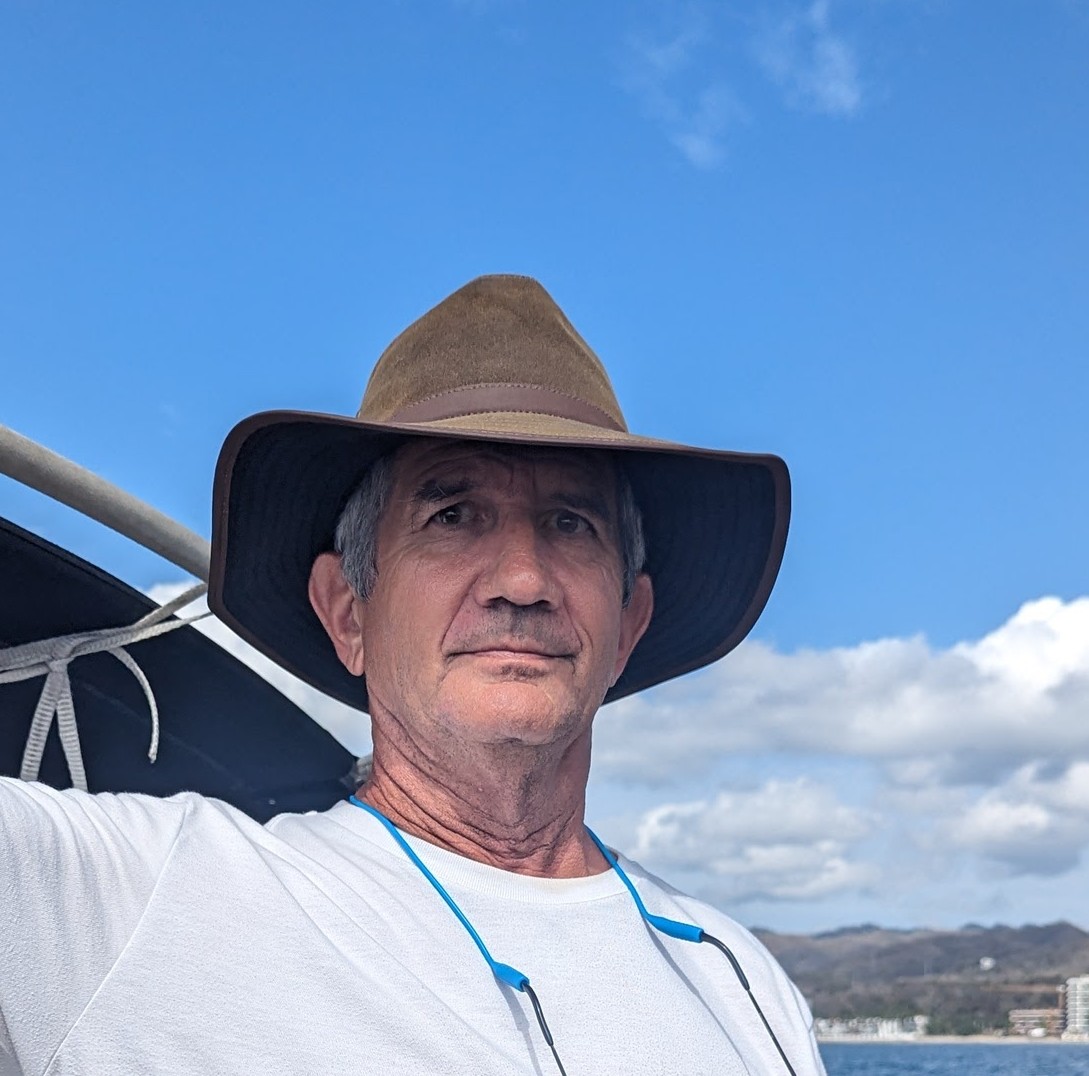COOKIES AND FARADAY CAGES
COOKIES AND FARADAY CAGES
*Seasonal Provisioning Tip*
This time of year you can get huge packages of food (cookies, chocolates, crackers) in special seasonal ‘cookie tins’. We on SV AVANT go crazy and stock up on them.
We keep the tins to use as faraday cages (store smaller portable electronics in them to protect them from the effects of a nearby lightning strike).
BONUS: Consumption of the contents can improve morale, as well.



SY AVANT 🇨🇦 Rob & Debra – Beneteau 43.5


Thanksgiving 2024
HAPPY THANKSGIVING

Happy Thanksgiving to All
Admirals, Captains, Skippers, Quartermasters and Crew,
May your anchors set in a deep broad bed of sand,
your sails, hearts and bellies be full.


This Thanksgiving there are many things to be grateful for. The open seas, remote anchorages, coves, beaches and oceans are still the best source of fresh air and wellness for explorers and seafarers alike. We reflect on all the things to be grateful for —friends, family, loved ones, and a well charted course are things to be cherished We want to thank you for being part of the Ocean Posse: a group of exceptional individuals who look at the horizon each day and say “where to next ?”
We are thankful to our Marina Partners and Sponsors who will host us, help us to re-provision, refuel, resupply, and rest so that we can get underway again.
Ocean Posse Team
Dietmar, Maurisa, Nicole, & Rob
![]()



TO STOP OR NOT TO STOP IN THE GALAPAGOS?
TO STOP OR NOT TO STOP
IN THE GALAPAGOS?

The Galapagos is undeniably on many a cruisers bucket list. However, depending on ones drive, timeline, and/or cruising budget, the in's and outs of navigating the entry requirements and fees can be anywhere from reasonable and attainable to impractical and impossible. Every year Ocean Posse boats are crossing the Pacific Ocean. Some boats plan a stop in the Galapagos, some boats make an emergency stop, while others still pass by en route to the Southern Pacific Islands further west. Erick and Jennifer from SV WINDSONG are among the fleet that planned their stop, made it happen, and adventured through the Galapagos. Here they share their experience getting the approval to stop, the real fees they incurred, and their adventures during their stay. Please Note: regulations and requirements change often so the exact requirements today may be slightly different. Resources are provided to get up to date information.
ERICK REPORTS:
As sailors begin to prepare their journey from the Americas to the South Pacific, the decision on whether or not to stop at the Galapagos islands looms for many. For most cruisers, the choice boils down to three factors: the activities and attractions in the islands, the cost of entry, and the hassle for cruisers to prepare and visit the islands. When my wife and I began our sail to the South Pacific from Panama in early 2023, we were enticed by the Galapagos and had ultimately decided to make the stop. We had no regrets, in fact, it was one of our favorite places we have ever been to. I hope this article gives readers a better understanding about the positives and negatives concerning the Galapagos stop, or at least give the readers better insight before making their decision.
Ocean Posse members work with Yacht Agents Galapagos: (/yachtagentsgalapagos.com) to handle all of the clearance and entry requirements. Agents are required for visiting yachts, and we were very happy working with Javier and his crew. For details and specific information regarding many of the requirements, costs, activities, restrictions and opportunities for cruising yachts, visit their website.
The very first factor cruisers should consider is why they should or shouldn’t stop in the Galapagos at all. For us, the islands hosted a wide array of incredible experiences that we couldn’t pass up. We were always enticed by the natural wonders of the islands, mostly as animal lovers and the opportunity to come face-to-face with unique and intense creatures. From the very moment you arrive at San Cristobal to clear in, you are greeted by the sea lions frolicking around the anchorage, audible with their distinctive barks. Many will be seen sleeping alone or in groups on unattended local boats, or even on some unprepared cruising yachts. We found them hilarious and endlessly entertaining. Other boats found them to be loud, stinky, obnoxious and more of a hassle. Aside from the sea lions, the islands offer wild experiences encountering sea turtles, giant land tortoises, a variety of unique birds, penguins and more! Our first warning here is: if you are not at all interested in animal encounters, you may not want to consider the Galapagos.




The islands offer a wide array of activities for many different interests and budgets. Many will enjoy world class scuba diving with abundant sea life that is rarely rivaled in the world; others will want to experience as much of the diverse landscapes such as the various volcanoes through hikes and tours, along with the intimate animal encounters wherever you go. A little known secret of the Galapagos islands is the world class surfing to be had for all ability levels. The exceptional and uncrowded surf breaks were the icing on the cake for us and our visit. While cruising between islands in the Galapagos, we experienced the most consistent and exciting offshore fishing on our entire cruise between Florida and Fiji. We had more tuna and mahi mahi than we knew what to do with, and made some life-long friends on other boats by sharing our catch.



When considering the long passage from the Americas to French Polynesia, the Galapagos islands seem like a nice stop along the way, particularly after the often frustrating slog through the doldrums. However, if the activities and abundant wildlife do not sound like something you are seriously interested in discovering, then I would suggest possibly skipping the Galapagos. Many cruisers we have heard of who chose to enter just for a convenient stop, rest and refuel are often the ones who will speak poorly of the experience. Many do not appreciate the frisky sea lions trying to board their vessel, find the cost of entry too much for just a convenient stop, and the entry requirements an extreme hassle.
If the wildlife and activities sound like a great idea to you, the next consideration would be the cost of entry. We knew this was a bucket-list item for us, and we would forever regret sailing past the islands. However, we are a low-budget boat, so we saved and trimmed other expenses to specifically afford the trip to the Galapagos. The fully loaded cost for entry for our vessel with 2 people was $2,277.60, including the Pacific Posse discount. The details of each cost are shown in the invoice image below. Certain costs scale by the amount of people on each boat, and the type of permit you seek for cruising. Please be mindful these costs were for our visit in March 2023, prices are subject to change.



Beyond the cost of entry, the cost of staying in the islands should be considered. We spent our full 30 day stay included in our fees, maximizing our time and value for the cost. By being able to stay on our own boat, we ultimately saved money for a comparable month-long stay by flying in and paying for lodging, food without our own kitchen, travel between islands, etc. Once in the islands, cost of living is not expensive especially compared to places down the line such as French Polynesia. Budget eating is easily accomplished, with delicious $5 USD Ecuadorian lunch specials that typically include a hearty stew, filling entree and fresh juice. Combined with the decently priced fresh produce, one can eat well on a budget with the boat’s galley available. There are also restaurants and bars for every other budget, including some great fine dining.
While in the islands, your activities can be tailored to your budget. We aimed to avoid costly tours as much as we could; opting to entertain ourselves with self-guided hikes, snorkeling from shore, walking to or taking cheap taxis (land and water) to different surf breaks, renting bikes to get around instead of cars, etc. Scuba diving and many of the more extensive tours will cost extra, as well as trips to the remote islands where cruising yachts do not have access.
The final consideration for stopping in the Galapagos for many cruising yachts is the hassle of entry. The requirements for entry are described on Yacht Agents Galapagos’ website, and their agents made the process easy to follow with checklists and frequent communication every step of the way. We can only speak of our experience preparing for the trip from Panama, where not only did Yacht Agents Galapagos make our lives easy, but also Ocean Posse Panama Canal agent Erick Galvez from Centenario Consulting. Erick offered extremely valuable services by arranging for many of the pre-trip requirements including the required bottom cleaning and fumigation certificates, as well as full service exit clearance help with the customs and immigration in Panama City. We had the benefit of beginning preparation many weeks ahead of our departure. If your schedule is very tight from transiting Panama or other ports to the Galapagos, then the hassle of preparation might be too much.
Beyond the preparation, the arrival procedures for the Galapagos islands can seem overwhelming, another potential turn-off for some cruisers. We first arrived at San Cristobal, the traditional check-in port for cruisers, and were greeted by a boat with divers who inspected our hull bottom before we anchored. We had stopped one day out from arrival in calm seas to give our hull one last cleaning, which we found necessary as some small barnacles had grown on our passage from Panama. If the boat bottom has growth, the officials will require you to sail far offshore and have a professional clean your boat before arriving. The divers found our work to be satisfactory, and had us proceed into the anchorage to await the clearance formalities.
After a brief wait at anchor, a boat arrived with an impressive amount of people from various sectors of the government, including our agent’s crew to aid with the process. We have a smallish boat, and have never hosted large gatherings before. The 10 people who came to our boat represented the most people we have ever had on our boat at one time! While overwhelming, we found the process was not overburdensome nor too intrusive. We were well prepared for the process and what would be inspected thanks to the checklists and instructions provided by the yacht agents, and after about 30 minutes we had all of our clearances and were prepared to enjoy the islands.
In summary, each yacht has different aims in what they want from their cruising adventure. If the unique natural environment, animals and world class activities available in the islands appeal to you; consider the cost and potential hassle of entry. If each consideration passes your muster, begin preparation as soon as possible by contacting Yacht Agents Galapagos and get the ball rolling. Like us, you may find that this stop becomes one of the most amazing parts of your entire cruise and an unforgettable experience.

THANK YOU FOR SHARING YOUR EXPERIENCE!
SV WINDSONG 🇺🇸 Erick & Jennifer - Downeaster Cutter 38′


PASSAGE REPORT: SV WANDERLUST FIJI TO NEW ZEALAND
PASSAGE REPORT: SV WANDERLUST
FIJI TO NEW ZEALAND
SV WANDERLUST crossed the Pacific Ocean and spent last season in French Polynesia. This season they cruised west through many islands with plans to spend cyclone season 2024/2025 in New Zealand. For the final leg of this part of their voyage, they sailed from Fiji to New Zealand. Here they share their Passage Report and Log:
The Fiji to New Zealand passage is notorious for its challenging weather scenarios. An approximately 1100 nm journey across open ocean with lows marching west to east every 5-7 days. Sailors typically depart on the tail of a low, enduring challenging conditions in the beginning in order to avoid getting smacked by a low with unknown conditions in the final stretch. Our situation has an added layer of complexity as we’re sailing with a dog that we’re exporting from Fiji to New Zealand. I’ll spare you the details but essentially we had to select our departure date 8 weeks ahead of time to start the testing and treatment required to import Yoda to New Zealand. We could not depart until the blood test results were issued from a lab in the United States which took 3 weeks and NZ Biosecurity regulations state the blood tests expire after 26 days which meant we had a 5 day departure window. Pair that with a nice bout of flu morphed into pneumonia for the captain and our departure options were slim. New Zealand Biosecurity confirmed Yoda’s blood tests would expire on 10/27 so we checked the weather and saw the winds were a bit patchy on a few days but we wouldn’t get clobbered, so decided to depart on Friday 10/25. Ship’s Log 10/25-10/26 Vuda Marina’s staff tied a beautiful floral wreath to Wanderlust for good luck and serenaded us with a beautiful song accompanied by guitar. Fijian lyrics told a tale of how wonderful it was to meet and spend time together, how they will miss us but wish us fair winds on our journey. Tears sprang to my eyes even though I’ve heard this sound countless times over the past week as nearly half the boats in the marina left for New Zealand and Australia. We met customs at 2:30pm in Vuda Marina and departed Fiji shortly after with the bow pointed towards Auckland! It’s not the ideal weather window but it’s good enough and Yoda’s (our French Bulldog) blood tests expire tomorrow so we’re off!

In true sailing fashion the first overnight was a fair amount of reefing and hoping the lightning stayed far
away but we were able to shake the reefs early this morning and are heading upwind at 8/9 knots. Our
wind instruments are acting up so we don’t have any true wind data but have apparent wind so as long as
that sticks around we’re good. 😊
10/26-10/27
Yesterday was one of the most beautiful sailing days we’ve had in a long time! Sunny skies, winds up to
20 knots on the beam or just forward so we could sail with the screecher most of the day. Our top speed
so far is 13 knots and our average for the first 263 miles is 7.5.


This morning the wind died so we had to engage the iron sails. 🤣 This was expected and we planned to use this time to finish cleaning our hull for NZ. Apparently you’re not supposed to clean your hull in Fijian waters and we were in a marina until we left so we had to do it at sea. I DO NOT recommend this. It was really tough even though the seas were calm and there was very little wind. First and last time for sure, but it’s done and the hulls & props are clean.




A bit before jumping in to clean the hull we caught a good size skipjack tuna! Needless to say we motored for about an hour from where we caught the fish before jumping in to clean the hull. Wind should fill in tomorrow morning. Until then we’ll be resting up!


10/27-10/28 Upwind Climb
We’ve been sailing upwind since midnight last night. Bashing into short choppy waves up to 22 knots
made for an uncomfortable night. Thankfully, the winds have eased up now and the ride is more
comfortable. Hopefully a better night’s sleep is in the forecast tonight.


10/29-10/30 Every Day is Different Out Here
We’re on Day 5 of our Fiji to NZ passage and every day has been different! Yesterday the wind died and
the ocean was like glass so we motored until early this morning when the wind picked up. Earlier today
we went through some squalls associated with the low passing to our south. Now we’ve got apparent
wind to 22 knots and we’re cruising along. ⛵🌊🙌

10/31-11/1 Happy Halloween
Happy Halloween from the high seas! It has been slow going with low wind and now no wind but we
suppose that’s better than getting hit by the low that went by to the south of us. We’re getting closer

11/1-11/2 Schizophrenic Day 8 & Land Ho
The day started out with no wind, then filled in a bit so we were able to hoist the sails. The breeze
continued to increase throughout the day, up to 27 knots but at least it was from behind. There’s a front
coming across New Zealand around midnight tonight with sustained winds of 25 knots gusting to 35. We’ll
probably get a bit of this but hope to make it to Auckland in the early morning hours.

11/1-11/2 Schizophrenic Day 8 & Land Ho
The day started out with no wind, then filled in a bit so we were able to hoist the sails. The breeze
continued to increase throughout the day, up to 27 knots but at least it was from behind. There’s a front
coming across New Zealand around midnight tonight with sustained winds of 25 knots gusting to 35. We’ll
probably get a bit of this but hope to make it to Auckland in the early morning hours.
11/2-11/3 We Made it to Auckland!
8 days 14 hours and 1227 nm later we are in Auckland! We arrived early this morning around 6am and
tied up to the customs dock. Customs, Biosecurity and the quarantine facility will be by this afternoon as
many of the streets are closed this morning for a marathon. We had winds to just over 30 knots on the
nose last night so it was like riding a bucking bronco for a few hours but other than that the trip was quite
comfortable. Though, we did motor more than we’d hoped. That’s what happens when you’re sailing with
a dog. You pick a window and usually stick with it. Overall we are thrilled with the outcome of this
notoriously challenging passage and are looking forward to our time in beautiful New Zealand!
SY WANDERLUST 🇺🇸 Kristin, Fabio, & dog Yoda - Seawind 1600




THANK YOU FOR SHARING YOUR ADVENTURES ON THE HIGH SEAS!
BUNDLED C'S POSSE PERK: COMMUNICATION, COMRADERIE, COMMUNITY
OCEAN POSSE PERK:
BUNDLED C'S
(COMMUNICATION, COMRADERY, COMMUNITY)
Some Ocean Posse Perks don't fit into one liners. Some are the product of the fleet and the way the Posse is purposely set up. Hence "The Bundled C's": this perk is really the result of the serendipitous, inner workings of many Posse Perks which include Communication, Comradery, and Community.
The Ocean Posse is a community of voyagers on their own schedules. Each member participates in one or all of several format options for communication undeniably developing comradery over the course of their conversations, meet ups, shared anchorages, sunsets, and information exchanges. This week was one of many examples between three vessels each in a different part of the ocean along their voyage connecting over where one might drop their hook after crossing into Panamanian Pacific waters from Costa Rican waters.
When a vessel checks out of Costa Rica in Golfito the authorities expect that, weather permitting, the vessel will then leave Costa Rican waters without stopping. Leaving Golfito, Costa Rica for Panama vessels go south to round Punta Burica and east into Panamanian waters. Punta Burica protects the waters and islands to the east from a lot of weather making for a pleasant cruise out of Costa Rica into Panama. Many vessels will tuck into one of the small, less travelled, and spectacular islands of Western Panama en route east to Panama City.

Today, there are a dizzying amount of chat groups out there for wherever you are.. The Ocean Posse uses the LineAp to have a focused, real time format for communicating among the fleet. General communication is usually short lest people take their conversations directly to one another. As rounding Punta Burica is a milestone along the Pacific Central American route, this week MV PAUSE reported :
Just rounding Punta Burica and are now in Panama from West Coast Cost Rica, headed to Isla Parida for the night. It has been pretty much non stop rain for 4 or 5 days now but fortunately no lightning.
This message came as an update on their progress. Fellow fleet member SV RAAJA replied from further east:
I spent several days anchored off of Isla Gomez. It is a tiny uninhabited island with a beautiful beach. Highly recommended if you are headed for Parida!
Another vessel SV JUBEL who spent time cruising this area last season replied from the north side of Panama:
Second this
MV PAUSE apparently swayed and please with the recommendations:
Just dropped the hook at Isla Gomez. Beautiful


THANKS FOR BUNDLING THE C'S TOGETHER & ENJOY THE ISLANDS!
MV PAUSE 🇺🇸 Beth & Larry - Nordhavn 55′, SV RAAJA 🇺🇸 Skip – J boat 46’, & SY JUBEL 🇨🇦 Leah & Kyle - Gulfstar 44'





TURNING WASTE INTO OPPORTUNITY AT FINCA HAMBURGO CHIAPAS, MEXICO
TURNING WASTE INTO OPPORTUNITY
FINCA HAMBURGO, CHIAPAS, MEXICO

Re-Creativa Sustentable Finca Hamburgo
At Re-Creativa, we are more than just a recycling project—we are a community of six women from Finca Hamburgo, deeply committed to turning waste into opportunity. What started as a simple idea has grown into a powerful initiative where we transform plastic waste into beautiful, functional products. Not only are we making a positive impact on the environment, but we are also creating economic opportunities for ourselves and other women in rural communities, right here in the heart of Chiapas, Mexico.

Our Journey to Sustainability
Living in the lush mountains of Chiapas, surrounded by breathtaking natural beauty, we’ve seen firsthand the challenges posed by plastic waste. There is little infrastructure here for waste management, and much of the plastic ends up in rivers or lands in open dumps, damaging our environment. We knew something had to change.
That’s when we teamed up with In Mocean and Finca Hamburgo, our home. Finca Hamburgo is a historic coffee farm in the heart of Chiapas, and it became the perfect foundation for us to build something meaningful. Together, we began the journey to create a space where we could recycle plastic waste and turn it into useful, sell'able products—helping the planet and creating opportunities for our community.

Transforming Plastic into Creativity
It all started with a workshop. Nike, a passionate sailor and founder of In Mocean, reached out to us and offered to lead an introductory workshop at Finca Hamburgo. We invited women and children from the community to join, and together we learned how to make simple drafts from shredded plastic. Over two days, the idea of Re-Creativa started to take shape. We realized we could turn plastic waste into something more—something creative, useful, and impactful.
From that moment on, we knew we had to build something lasting: a community-led recycling workspace where we could create, learn, and contribute to a cleaner, greener future.

Setting Up Our Workspace
With support from In Mocean, the REESE Gruppe, and generous donors, we received the equipment we needed—machines like a shredder and an extruder. Just two weeks after our first workshop, Nike and Maria (co-founder of In Mocean) returned to Finca Hamburgo, and we got to work. We learned how to operate the machines, sort plastics, and use our creativity to make products that would not only help the environment but also generate income.
Our first creations were colorful earrings made from shredded plastic. We quickly began to experiment, crafting bowls and beams using the extruder. But it wasn’t just about making things—it was about learning how to run our new workspace as a small business. We discussed how to generate income, market our products, and sustain this new venture for the long term.

Early Successes and Growing Together
As we took ownership of Re-Creativa, we named our workspace and even designed our logo. We set up an Instagram account to showcase our creations, and soon, the sales started rolling in. The money we earned helped support our families and fueled our passion for the project. With each new product, we saw our skills grow, and we began working on a new goal: our first prototype for a chair made from recycled beams.
What makes Re-Creativa so special is the sense of community we’ve built together. We are no longer just recycling plastic—we are creating something bigger than ourselves. The bond we share as we work, learn, and grow together is the heart of this project. We’ve even begun hosting workshops in schools and cultural centers in Tapachula, sharing our journey and encouraging others to join the movement.

A Beacon of Sustainable Change
For us, Re-Creativa is more than just a workspace—it’s a beacon of hope. It shows that even small, simple actions can lead to big changes. By turning waste into valuable products, we’re not only helping the environment, but we’re also creating opportunities, building a sense of community, and inspiring others to act.
As we continue to grow, we are more determined than ever to transform waste into creativity, opportunity, and empowerment. We know that this is just the beginning, and we’re excited to see where this journey takes us.

Join Us for a Recycling Workshop and Visit Finca Hamburgo
We’d love for you to come and visit us at Finca Hamburgo. Experience the beauty of our home and see firsthand the work we’re doing at Re-Creativa. Join us for a hands-on recycling workshop, where you’ll learn how we turn plastic waste into creative, functional products. It’s a chance to connect with our community, see the impact of our work, and be part of the positive change we’re building together.
ANNOUNCING: THREE SHEETS REGATTA IN THE VIRGIN ISLANDS
ANNOUNCING: THREE SHEETS REGATTA
SAILING AND PARTIES COMING UP IN THE VIRGIN ISLANDS

The organizers invite you to join them for some spectacular sailing during the Three Sheets Regatta this December.
The Three Sheets Regatta, officially organized by the Virgin Islands Sailing Association (VISA) with sponsorship from the three island yacht clubs—St. Thomas, St. Croix, and St. John—promises an unforgettable experience on the water.
This year’s regatta will feature two signature races:
- The Three Island Race
- December 6: St. John to Frederiksted, St. Croix
- December 7: Frederiksted to St. Croix Yacht Club
- December 8: St. Croix Yacht Club to St. Thomas Yacht Club
- The Around the Island Challenge
- December 6: St. Croix Yacht Club to Frederiksted
- December 7: Frederiksted to St. Croix Yacht Club

We’re particularly proud to have VISA as the official race organizer, bringing its dedication to promoting sailing in the Virgin Islands. The full support of the three major island yacht clubs adds an extra layer of community and collaboration to this year’s regatta.
You’ll get to experience the stunning Virgin Islands from the water while connecting with a vibrant community of fellow sailors.
For more details, please check out our website: www.threesheetsvi.com. If you have any questions or need assistance with arrangements, feel free to reach out—I’d be thrilled to help.
Hope to see you on the water in December!
Juliet San Martin, President
Virgin Islands Sailing Association
Teamwork makes dreams work.
PASSAGE REPORT SV GARGOYLE GREECE TO SICILY
SV GARGOYLE BIDS FAREWELL TO GREECE & HELLO TO SICILY










SV GARGOYLE 🇨🇦 Kevin & Carla – Beneteau 50’

THANK YOU FOR SHARING THIS SPECIAL PLACE!

NEW BOOK BY LIN PARDY
Lin Pardey's New Book
Passages: Cape Horn and Beyond - Sailing through life’s changing currents
*hot off the shelf*

Join Lin as she shares challenging sailing, gentle voyages, the shoreside encounters that await once you venture into the world of cruising under sail. Far more than just a sailing adventure, this book is also a true memoir. As she and Larry sailed north from Cape Horn to Canada, then westward across the Pacific, they had to weather the emotional passages that come with growing older. Lin chronicles the last years she shared with Larry, the solo adventure that followed and, eventually, the romance and challenge of building a new life and voyaging onward with a different partner after David sailed in to anchor near her island home. Passages: Cape Horn and Beyond will appeal to sailors of all generations as Lin pours her heart out to tell tales of sailing through gales and calms, adventures small and large. It is a love story -- of sailing, of the sea, and of the two men who have shared Lin’s life.
Currently Lin's latest book is available for purchase in two locations. Click the location for purchase link:
- Paradise Cay Publications (Lin earns double the royalty from books purchased here) The book is a best seller on Paradise Cay Publications.
- Amazon also has the book available in Kindle or Paperback formats
What the reviewers say:
“Lin Pardey's Passages: Cape Horn and Beyond is a passionate and well-told recounting of the adventures and triumphs, as well as the trials and tribulations, since rounding the Horn "the wrong way" with her husband, Larry, in 2002. It's a remarkable book — fierce, honest, truthful and heartbreaking. And as with every Pardey book, extremely open and well-written. Passages succeeds as a touching memoir and a deep love story (in two parts), but most of all, as a rollicking good sea tale. I forgot how much I loved a good old-fashioned Lin Pardey first-person nautical narrative until I opened this one.”
- Herb McCormick, author and roving editor – Cruising World

"This is a brave book, written by an indomitable woman and sailor who, now 80 years old, continues to live life “all the way up.” It honors the man with whom she shared more than 50 years of that life voyaging the world’s oceans and inspiring generations of sailors. And though it sails straight on into the hardest of life’s passages, it also celebrates the light that emerges when one has had the strength and courage to endure the storm."
- Wendy Mitman Clarke, Editor-in-Chief, SAIL Magazine
“The title reflects both the thrilling sailing adventures of Lin and Larry Pardey and the profound changes in Lin's life. Sail with them around Cape Horn and across the Pacific, then follow Lin's inspiring journey as she navigates Larry's failing health and begins a new chapter with David Haigh aboard Sahula. I absolutely loved this!”
- Carolyn Shearlock – Creator of TheBoatgalley.com
“This isn’t just a bold sea story of a brave couple taking on Neptune — it’s a saga of the race against
the true universal ruler herself, Mother Nature. Author and adventurer Lin Pardey takes readers on a
gripping journey as she herself comes to grips with the inevitable forces that control all our lives. You
won’t be disappointed. Trust me.”
- Elaine Lembo, editor in chief, Caribbean Compass
“Lin Pardey’s new book just may be her best. It’s a classic Pardey voyaging narrative, as Lin and Larry
sail to the far south and round Cape Horn, but it’s so much more. It’s filled with wisdom and love, as
Lin chronicles Larry’s slow decline with perspective and deep gratitude for the life they were able to
share. And it’s filled with hope and optimism for the future, a blueprint for how to keep living as we get
older. It’s a terrific story.”
— John Kretschmer, adventurer/author, Sailing a Serious Ocean
Ready, Aye, Ready!
Ready, Aye, Ready!
“Ready Aye Ready” is the motto of the Canadian Navy. It implies that the Canadian Navy is always “ready”.
By Rob Murray on SV AVANT

We have been sailing Avant in Mexico and Central America for 11 years now, and one of the most common questions we get is “Do you feel safe?”
Yes, we do. We have not suffered a loss, seen a crime committed, or otherwise been bothered by crime. Ever. We do know of other cruisers that have suffered losses, though:
- Dinghy theft. (Really, it’s outboard motor theft. By far the most common loss suffered by cruisers.)
- Casual theft (thieves sneak aboard, usually when no one is aboard, and grab any valuables they can and dash off. Most common at a dock).
- Pick pockets (in Guaymas, a cruiser had her wallet stolen from her purse in the grocery store – but that could have happened anywhere in the world).
Not to say it doesn’t happen, it does. But the violent crimes that make the news in Canada and the USA do not seem to happen on the coast or where the cruising community congregates. Most if not all of the murders are gang related, and mostly gang on gang events. We take normal 21st Century precautions; we don’t walk in strange neighborhoods at night, we don’t flash wads of cash, we don’t wear expensive jewelry or watches, etc. and we have not had a problem.
There are, however, security concerns and we have taken some simple steps to protect ourselves.
You don’t need to make it impossible to be a victim, you don’t need to make it impossible for someone to steal from you. You just need to make it harder. You just need to make your boat a less inviting target than the one next door. If you have locked your boat and hoisted your dinghy and outboard out of the water, cleared valuables from the cockpit, and a neighboring boat has all their hatches open and their dinghy floating beside their boat tied on with a rope painter, guess who is more likely to be a victim? It’s like the old joke about bears, you don’t need to be able to outrun a bear, you just need to outrun the person you’re with.
The strategy we have employed for our personal security is pretty simple and pretty unobtrusive. It doesn’t impact our day to day lives by much, and we aren’t working hard to stay safe.
-
- Lock the boat, and tidy up. Simple. Free. Easy. When we’re away from the boat for a while, whether at the dock or at anchor, we lock the boat. Close and latch the hatches. Even if we haven’t seen another human being for days. We also have the means to lock ourselves in the boat, in the event we feel threatened and think that’s the safest option (boats with the hatches locked by padlocks may not have the means to do this, but it’s pretty easy to add an internal barrel bolt or similar lock). We changed out our lovely louvered wooden companionway boards for a simple sheet of plexiglass, far more resistant to being kicked in or carved open with a knife or chisel. We don’t stow anything within reach of the portlights we usually leave open. We stow winch handles and other deck gear below as appropriate when anchored or at the dock, and don’t leave things sitting around on deck or in the cockpit. We also lock the computer at the navigation station to the boat with a computer cable lock.
- Hide stuff. In the event someone does get aboard, we have some of our valuables and some spare cash hidden. We use a variety of means, including ‘diversion safes’ (food cans, boxes or jars, varnish or paint cans or bottles, hollowed out books, etc., that disguise a secret compartment to stash valuables in). These can be purchased or home made (paint the inside of an old mayonnaise jar white, and there you go!). More than one is a good idea, in various places around the boat. The downside is they can be taken as they are portable. Don’t use a WD-40 can as a diversion safe in your tool bag, as they may take the whole bag!

- Secret compartments/ hidey-holes. False drawer or locker bottoms, behind velcroed-on cabinet fronts or vinyl trim, envelopes taped behind or under drawers, the inside of the paper towel roller, shower curtain rod or toilet paper roller, false electric sockets, the inside of hollow closet rods, and other strategies can be employed.

- Use decoys. We have a ‘muggers wallet’ prepared and left in plain sight on the navigation station, next to the companionway. A muggers wallet is a decoy wallet, an old, used one filled with expired credit cards and identification, receipts and small denomination bills of assorted currencies. The hope is a sneak thief will come aboard, see and seize the wallet and dash off, satisfied they have ‘scored’, while truly valuable goods remain unmolested.

- Have backups. We have backup credit and ATM cards, connected to a separate bank account at a different bank from our primaries, safely stashed aboard. If our primary cards are lost, compromised or stolen, or if our primary bank has a bad hair day in the computer department, we can dig out the backups and be good to go until replacements can be sourced or the accounts reactivated.
- Know what’s there. We take pictures of our passports and the contents of our wallets and the interior of the boat and email them to ourselves so we have a record that we can access from any computer on the internet if they are lost.
- Be ready with active deterrents. In the extremely unlikely event we meet serious thieves intent on a face to face encounter and committing a violent crime against us, we are ready to meet the threat (at least with bravado). We have:
-
- Heavy flashlights (3 cell D battery Maglites) mounted in clips next to the companionway and our berth. As well as being handy, blinding flashlights, these make great clubs.

- Fire extinguishers will discharge a large cloud of fine white dust that can disorient and confuse bad guys.
- Machetes. We have a couple of machetes aboard, stored in a locker where they can be reached quickly and waved around to make a show of resistance. Easily seen from a distance, waving machetes is a distinctly unwelcoming gesture in every culture. Machetes are inexpensive and readily available in hardware stores. They can also be used to open coconuts.

-
- Baseball bat. We also have a t-ball bat (mini baseball bat), which doubles as a fish bonker.
- Flares. We have a white handheld flare mounted in clips in the companionway. In the event we are intercepted at sea or boarded at anchor, we can light it and toss it in an attacker’s boat. We don’t have a flare gun aboard, but one might be useful. Be aware that the flare shot from a flare gun will not light until the flare has burned for a while (they are designed to light in the air, not as they are discharged). They are not particularly powerful, and the flares with their propellant tend to bounce off what they hit. The muzzle energy of a 12g flare gun is less than that of a 22 caliber rifle and it is unlikely to penetrate just about anything due to its wide nosed projectile. Any damage it may cause will be due to the flare itself burning. Flare guns may also be illegal in certain jurisdictions (and if used in an offensive or defensive manner as a weapon, are considered weapons or firearms under the laws of many countries).
- We have Bear Spray aboard, too (while wasp spray is often suggested as a deterrent, apparently it is largely ineffective).
-
- (Note: In most countries south of the USA, Mace, Dog and Bear Sprays are illegal, but we’re living on the edge).
- We keep our VHF on 24/7, and keep a handheld next to our berth, so we can raise an alarm with other cruisers (or heed their call) if we feel unsafe.
All of these strategies are designed around the idea that you don’t have to make it impossible to be attacked, you just have to make it unpleasant for would-be attackers, encouraging them to look elsewhere or take the rest of the day or night off.
Dinghy Outboard Theft
This is, by far, the most common loss suffered by cruisers. An outboard is a very valuable item in a fishing community, and all coastal villages are fishing communities. A simple 8-10 hp outboard can increase a fisherman’s ability to feed his family tenfold by allowing him to get further offshore when fishing. We always hip-hoist our dinghy at night, and do so with a wire cable harness with legs long enough to be far above reach, where they are attached to the halyard snap shackle, even when standing on deck (so a would-be thief can’t simply release the shackle and drop the dinghy). We lock the outboard to the dinghy’s transom with a heavy stainless lock, and use the same lock to lock the motor to the rail mount when it is stored aboard. We employ locals (usually children or the proprietors of beachfront restaurants) as watch keepers whenever possible when leaving the dinghy ashore, and use a long stainless cable to secure the dinghy ashore when it’s in an isolated or unsupervised location.
We don’t really notice that we’re doing these things on a day to day basis, they are just ‘habits or ‘housekeeping’. But we feel that these measures collectively decrease our chance of being victims (and losses if we are), as well as increase our ability to bounce back should we be targeted.
EDITORS NOTE:
Additionally, there is a huge resource in the Caribbean Safety and Security Net available for private cruising vessels. Their website is extensive and their incident reports are kept up to date. Their guidelines for precautions are applicable across all oceans.
https://safetyandsecuritynet.org/regional-piracy-infographics/
https://safetyandsecuritynet.org/piracy-passage-precautions-central-america/










